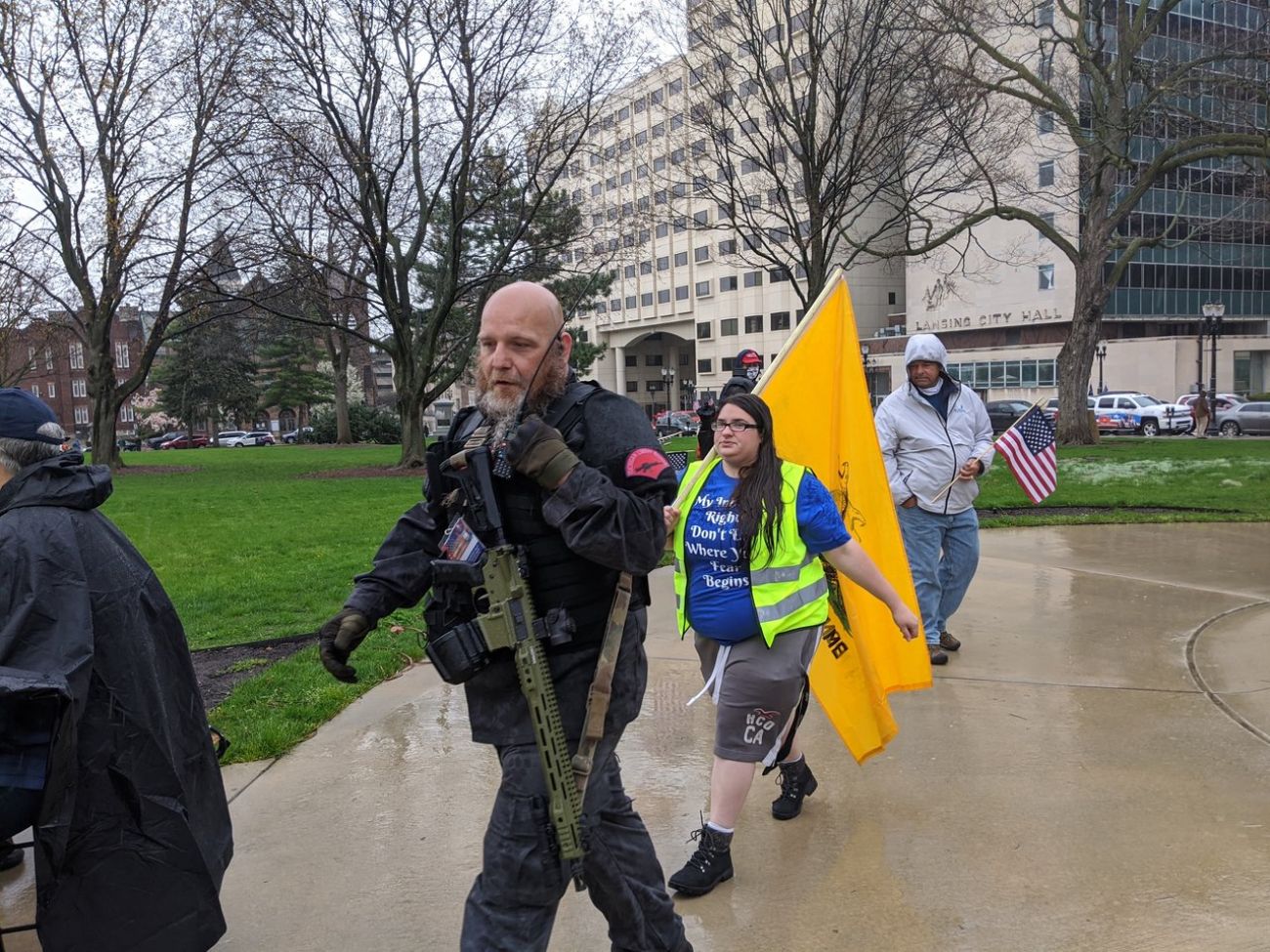Maybe it’s time to rethink allowing guns in Michigan Capitol, officials say


Jan. 11, 2021: Michigan bans open guns at Capitol, nearly a year after armed protest
LANSING— It happens at least once a year at the Michigan Capitol: Armed demonstrators openly carry firearms into the historic building and watch the Legislature from galleries overlooking the state House and Senate chambers.
There are no metal detectors, no weapon checks and no policy to prohibit loaded weapons.
But longtime observers say the scene that unfolded Thursday at the Michigan Capitol — where riled protesters armed with rifles heckled lawmakers from the spectator gallery and shouted at police, garnering national attention — was far different than annual Second Amendment rallies, where gun activists celebrate their rights.
And its prompting renewed debate over whether new policies are warranted.
- The latest: Michigan coronavirus map, curve, chart, updated COVID-19 news
- Michigan’s latest stay-home order to allow landscaping, boating and golf
- What Gov. Gretchen Whitmer’s stay-at-home executive order means to Michigan
Directly above me, men with rifles yelling at us. Some of my colleagues who own bullet proof vests are wearing them. I have never appreciated our Sergeants-at-Arms more than today. #mileg pic.twitter.com/voOZpPYWOs
— Senator Dayna Polehanki (@SenPolehanki) April 30, 2020
Some demonstrators who carried assault-style rifles into the Capitol during a protest over Gov. Gretchen Whitmer’s stay-at-home order were identified by organizers as militia members, a civilian military force acting as a “security detail” for the protesters.
One reporter said she was “slammed in the head” by a rifle while attempting to cover the chaos, and multiple lawmakers said armed demonstrators shouted at them from the Senate gallery as they worked below and awaited GOP legislation to authorize legal action challenging Whitmer’s emergency authority.
Sen. Sylvia Santana, D-Detroit, said the scene made her so “fearful” she wore a bulletproof vest at her desk. “It makes the work environment very, just, temperamental when you’re trying to work with colleagues on both sides of the aisle,” she told Bridge Magazine Friday.
While there was no physical violence, and most of the hundreds of demonstrators were not armed, at least one protester held a sign encouraging violence against Whitmer: “Tyrants Get The Rope.” Another brought a Confederate flag outside the Capitol in apparent ode to the Civil War.
Whitmer called the protest “disturbing.”
Senate Majority Leader MIke Shirkey, a Second Amendment champion who has encouraged demonstrations against the governor, on Friday denounced some among the protesters as “a bunch of jackasses.”
“Many protested safely and responsibly, and I respect and appreciate their efforts,” Shirkey, R-Clarklake, said in a statement. “Several other so-called protestors, used intimidation and the threat of physical harm to stir up fear and feed rancor. I condemn their behavior and denounce their tactics.”
Michigan is among a handful of state capitols with no rules prohibiting firearms or requiring visitors to pass through metal detectors. Visitors are, however, banned from bringing signs or posters inside, a policy ostensibly designed to prevent damage to walls of the historic building.
It’s been that way for as long as John Lindstrom can remember.
The recently retired publisher of the Gongwer subscription newsletter, a journalist who spent 42 years covering the Capitol, recalls only a handful of instances where stronger regulations were temporarily put in place.
“You can't carry a gun into a courthouse, you can’t even carry a phone into a courthouse, and yet we are literally operating with people hovering over us with their weapons.” — Sen. Jeremy Moss, D-Southfield
In 1999, for instance, House Republican leadership installed a metal detector outside the gallery amid protests over Republican Gov. John Engler’s plan to take over struggling public schools in Detroit.
“It was mostly protesters from the city, and there were a lot of objections to that,” Lindstrom said, referencing the predominantly African-American city. “A lot of (protesters) were very upset and argued they were being discriminated against, treated badly, because they were forced to go through a metal detector.”
There were no similar safeguards when an overwhelmingly white group of protestors rushed into the Capitol on Thursday.
In late 2012, Michigan State Police closed the entire Capitol building to visitors amid a massive protest over controversial right to work legislation after arresting eight people who they said attempted to push past troopers and rush the Senate floor.
The longstanding ban on signs, which sparked free speech complaints, may date back to the 1980s, when someone in a union protest over workers compensation changes damaged a painting of former Gov. Kim Sigler, according to Linstrom.
The Michigan Capitol Commission writes rules for visitors to the building but has not adopted any regulations on firearms, citing Constitutional guarantees. The makeup of the commission is largely decided by legislative leaders, currently Republicans, who effectively appoint four of six members.
“We have been following the statutes,” said Michigan Capitol Commissioner John Truscott, who served as press secretary to GOP Gov. Engler. He noted there are not any laws prohibiting firearms at the building.
But Truscott acknowledged commissioners are reviewing open-carry laws and discussing whether regulations at the Capitol are in order.
“With this being thrust in the national spotlight, it's raising a lot of questions,” he told Bridge Magazine.
Metal detectors have been used during presidential visits in the past, Truscott said. Then-President Bill Clinton, for instance, spoke at the building in the 1990s, and the Secret Service implemented several strict security measures at the time.
But in general, “our goal has been to keep the building as open as possible to the public,” he said.
In recent years, Democrats have proposed banning guns in the Capitol, but they have had no luck as the minority party in both the House and Senate since 2010.
Sen. Jeremy Moss, D-Southfield, said he hopes this week’s scene at the Michigan Capitol will renew interest in legislation he has sponsored with Rep. Robert Wittenberg, D-Huntington Woods, that would prohibit guns in the Capitol but allow signs.
Armed demonstrators shouting at lawmakers from the Senate gallery Thursday had a clear motive, he said: “It was intimidation.”
“I don't even think they knew who they were yelling at,” Moss said, noting the Senate went in and out of recess several times as GOP leaders worked on legislation attempting to limit the governor’s emergency authority. “They were heckling Democrats because they knew what our position was, but they were also calling the Republicans spineless for delaying the action.”
While he waited for Republicans to begin voting, Moss said his social media feeds were flooded with questions from users across the country wondering about the armed protesters.
“How can this happen?” they asked, according to Moss. “You can't carry a gun into a courthouse, you can’t even carry a phone into a courthouse, and yet we are literally operating with people hovering over us with their weapons.”
Tom Lambert, legislative director for Michigan Open Carry Inc., has lobbied lawmakers against limiting guns at the state Capitol and said it would be a mistake to change rules even if some legislators felt “threatened” this week.
“If that's the standard we're going to use for things, where does that stop?” he said. “Do we limit constitutionally protected assembly based on a subjective fear, especially one where no one has ever been harmed? I get there's the possibility out there. But we don't take these big steps based on possibilities.”
From pictures he saw from Thursday’s protest, Lambert said the armed protesters did not appear to “brandish” their weapons, according to state law, which defines brandishing as pointing, waiving or displaying a firearm “in a threatening manner with the intent to induce fear in a reasonable person.”
“Simply displaying a firearm, simply carrying a firearm is not intended to cause fear,” Lambert said.
Santana said she was afraid Thursday, and not just because of the armed protesters.
She was already on edge after watching demonstrators at a previous April rally waive Confederate flags, invoking memories of legal slavery, and angry that a Republican Senate colleague had worn what appeared to be a Confederate-print facemask on the floor the week before.
Santana introduced legislation this week that would prohibit Confederate flag displays on Michigan Capitol property and said she also thinks it’s time to “revisit” building firearm rules.
“There was no way that I was going to come and do the business of the day and work in a bipartisan fashion with the fear of somebody having the ability to shoot,” she said.
RESOURCES:
- Hey, Michigan, here’s how to make a face mask to fight coronavirus
- Michigan coronavirus dashboard: cases, deaths and maps
- Michigan families can get food, cash, internet during coronavirus crisis
- How to give blood in Michigan during the coronavirus crisis
- 10 ways you can help Michigan hospital workers right now
- Michigan coronavirus Q&A: Reader questions answered
- How to apply for Michigan unemployment benefits amid coronavirus crisis
See what new members are saying about why they donated to Bridge Michigan:
- “In order for this information to be accurate and unbiased it must be underwritten by its readers, not by special interests.” - Larry S.
- “Not many other media sources report on the topics Bridge does.” - Susan B.
- “Your journalism is outstanding and rare these days.” - Mark S.
If you want to ensure the future of nonpartisan, nonprofit Michigan journalism, please become a member today. You, too, will be asked why you donated and maybe we'll feature your quote next time!


